Senior Projects 2018
Katie Bruegge - Turán's Theorem and Kneser's Conjecture, Advisor Dr. Esmeralda Nastase
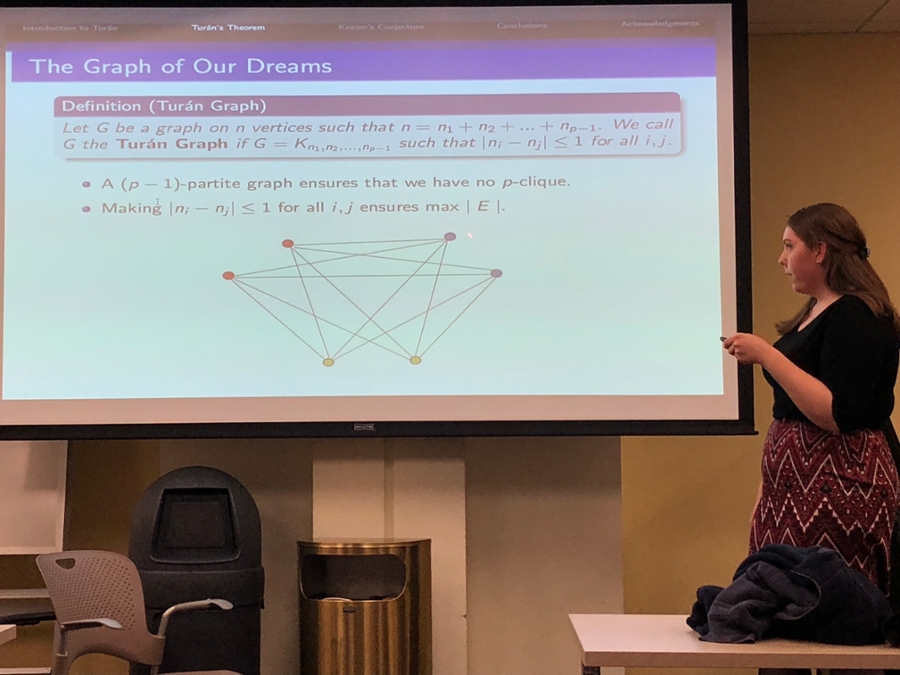
In this talk, we address two interesting problems in graph theory. First, we investigate Paul Turán's famous question from 1941: If a graph G has no complete subgraph on p vertices, i.e., a p-clique, what is the maximum number of edges that G can have? We explore the construction of the Turán graph, which is designed to contain the most possible edges on n vertices without inducing a p-clique, and prove Turán's Theorem, which states that no graph on n vertices, without a p-clique, has more edges than the Turán graph.
Second, we take a look at Kneser graphs, a graph family for which the vertices and edges are defined by sets of integers and the special relationships between those sets. We introduce Kneser's Conjecture which concerns the chromatic number of a Kneser graph, and present in detail its unconventional proof, which takes an unexpected turn into another dimension.
Patrick T. Gemperline - Computational Optimization of Monte-Carlo Simulations of Magnetic Ising Models, Advisors Dr. David Gerberry and Dr. Jonathan Morris

Sodium cobaltate, NaxCoO2, has versatile characteristics that have been studied as potentially being used as a battery cathode, good thermoelectric material, and a superconductor when hydrated. Mobile sodium ions in NaxCoO2 can occupy two energetically different neighboring sites in the crystal structure. By mapping the neighboring sites onto Ising spins we are able to study the ground-state structures using Monte-Carlo simulations. Models of this type fall into the category of computationally intensive due to the amount of time and CPU resources needed to complete them. As the number of atoms in the crystal being modeled increase the number of calculations increases at an exponential rate. In order to deal with this behavior of the model, several optimizations were performed. In addition to general computational optimizations, various sampling methods of parameter space (i.e. uniform grid, Monte Carlo sampling and Latin Hypercube sampling) are compared to show how computational efficiency can be improved while retaining the completeness of the simulation results.
Xavier Genelin - Optimizing Football Play Calling in a Goal Line Situation, Advisors Dr. Danny Otero and Dr. Edward Kosack

In football, the play calling strategies of coaches are very important to whether the team is successful or not. A game may come down to a single decision which can lead to a team winning or losing a game, and sometimes even a championship. The coaches typically use past experiences, personal philosophies, and other observable factors in deciding what play to run. One method that can be applied to find the best decision in the interaction between the offense and defense is game theory. In this paper, game theory is used to find the optimal decision for plays that happen within 10 yards from the goal line. Using game theory, a model is made to find the decision that will maximize points scored for the offense and minimize points given up by the defense. The decision is dependent on what their opponent is likely to do based on the situation and the efficiency of both the offense and defense. From this theoretical model, a coach can make a more informed decision as to which play to call based on available data and it can be used to analyze previous decisions made.
Winston Kunkel - Understanding Rotavirus through Compartmental Models: Disparities in Developing and Developed Countries, Advisor Dr. Hem Joshi
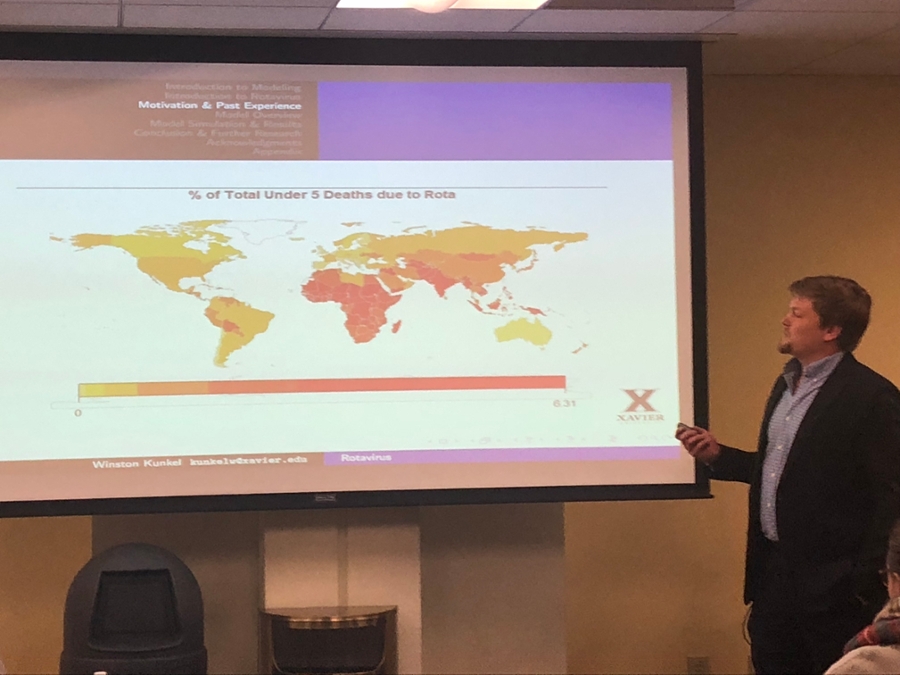
Rotavirus, the leading cause of diarrhea, accounts for nearly a quarter million deaths in children under five years old worldwide, most occurring in low-income countries. We simulated dynamics of the virus by creating a model in a developed country, the United States, and a developing country, Angola. Parameters for the model were collected from the existing body of research as well as government databases. The dynamics of rotavirus, prevalence of the virus throughout the duration of an outbreak, and the death toll resulting from the outbreak were compared across the population. We calculated the disease-related death in both countries and observed that it is nearly 1700% higher in Angola. In conjunction with the analyses, this paper seeks to highlight the widening gap in global healthcare, especially in children.
Aaron Moehring - The Zero Forcing Number and Minimum Rank, Advisor: Dr. Minnie Catral
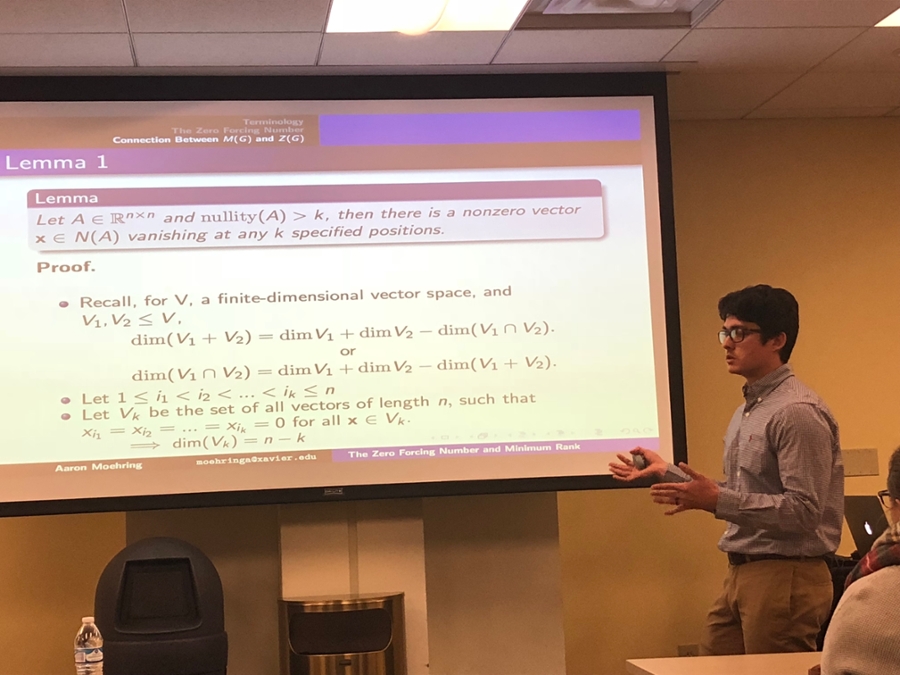
A zero forcing set of a graph G is a set of vertices such that when colored will color all other vertices following a certain color change rule. The graph parameter Z(G) is the least number of vertices necessary to produce a zero forcing set. As it turns out, this graph parameter allows for the computation of the minimum rank of specific families of matrices associated with G by providing an upper bound for the maximum nullity of such matrices.
Mary Moesta - Using Markov Chains to model and Test Traditional Baseball Strategy, Advisor Dr. David Gerberry
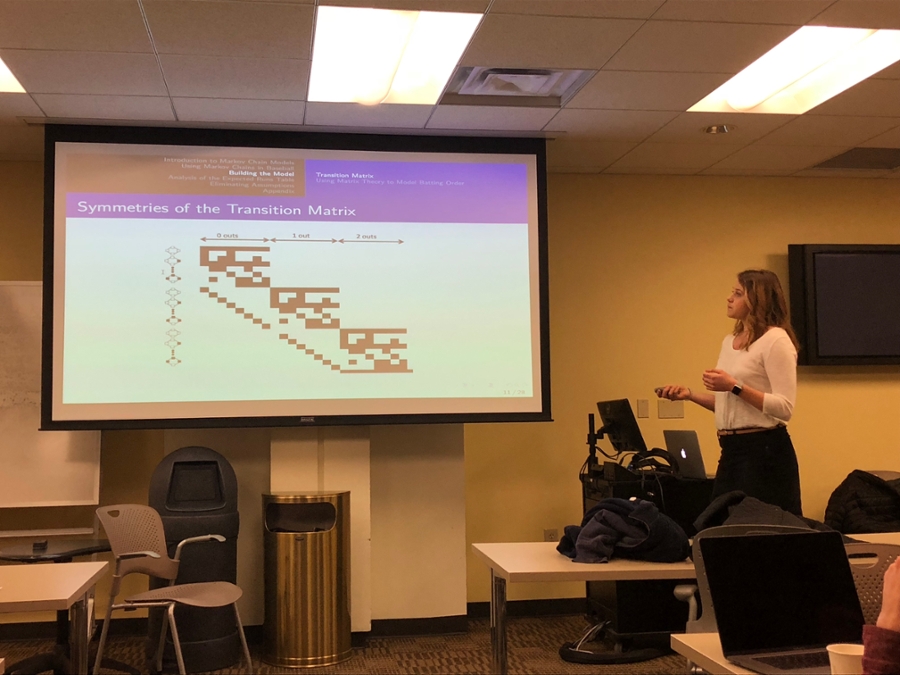
Quantitative approaches are becoming increasingly important everywhere especially areas in which large amounts of data can be collected. The world of sports, in particular baseball, is not immune from this quantitative approach especially due to the increased collection of baseball statistics in the recent decades. More specifically, data-based methods can shed new light on traditional questions of baseball strategy, including: Should a batter sacrifice bunt to advance runners on base? Should a pitcher intentionally walk a strong hitter? An optimized batting order? The progression of an inning in baseball can be modeled using the mathematical concepts involved in Markov Chains. Using theoretical results from matrix theory and Markov Chains, one can calculate the expected runs to be scored in an inning. With these predictions, one can make informed decisions about baseball strategy that is driven by data.
Jennifer Rustige - Double Counting and Sperner's Lemma, Advisor Dr. Esmeralda Nastase

In this talk, we show how the combinatorial technique of double counting helps solve the following interesting problems. First, we consider the question "What is the maximum number of edges in a graph, G, with no cycles of length 4?" We use double counting to prove an upper bound to this question, and show that this upper bound is almost optimal. Second, we employ double counting to prove Sperner's Lemma, and show how Sperner's Lemma can be applied to prove Brouwer's famous Fixed Point Theorem.
Eric Smail - A Survey of Subgroup Lattices, Advisor Dr. Jim Snodgrass
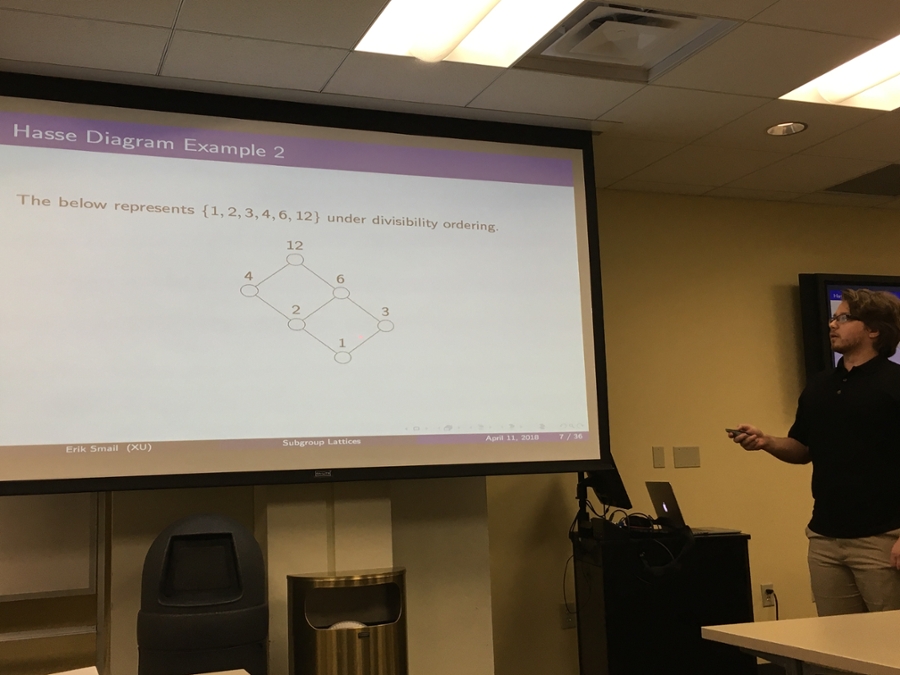
In this talk we introduce partially ordered sets, lattices, modular and distributive lattices, and their diagrams. We then proceed to discuss various subgroup lattices, as well as some interesting questions concerning them. What does the diagram of a lattice tell us about that lattice? Which groups are uniquely determined by their subgroup lattice? Which lattices are subgroup lattices? What do the properties of a group tell us about that group's subgroup lattice?
Catherine Smith - Snapshots of Mathematical Cartography, Advisor Dr. Danny Otero

Various types of map projections will be explored, including azimuthal, cylindrical, and conic projections. To illustrate these concepts, three maps of the United States are constructed using the Mercator Projection, Azimuthal Equidistant Projection, and Mollweide Projection.